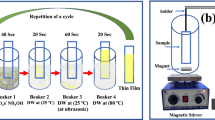Abstract
Copper–tin (CuxSn1−x) nanocluster is a promising system for gas sensing applications, mainly because of its sensitivity and selectivity for H2S. In this work, pure Sn and Cu as well as composite CuxSn1−x nanoclusters were synthesized using the dc magnetron sputtering gas condensation technique. Nanoclusters with different Sn to Cu ratios were produced by changing the ratio of Sn and Cu in the target. The dependence of Sn, Cu, and CuxSn1−x nanoclusters’ size distribution on various source parameters, such as the inert gas flow rate and aggregation length, has been investigated in detail. The results show that as the inert gas flow rate increases, the mean nanocluster size increases for Sn, decreases for Cu, while increases and then decreases for CuxSn1−x. The results could be understood in terms of the contribution percentage of the nanocluster formation mechanism. Furthermore, this work demonstrates the ability of tuning the CuxSn1−x nanoclusters’ size and composition by a proper optimization of the source operation conditions.







Similar content being viewed by others
References
P. Mazzoldi, G.W. Arnold, G. Battaglin, F. Gonella, and R.F. Haglund: Metal nanocluster formation by ion implantation in silicate glasses. J. Nonlinear Opt. Phys. Mater. 5, 285 (1996).
A. Martucci, M. De Nuntis, A. Ribaudo, M. Guglielmi, S. Padovani, F. Enrichi, G. Mattei, P. Mazzoldi, C. Sada, E. Trave, G. Battaglin, F. Gonella, E. Borsella, M. Falconieri, M. Patrini, and J. Fick: Silver-sensitized erbium-doped ion-exchanged sol-gel waveguides. Appl. Phys. A 80, 557 (2005).
Karvianto and G.M. Chow: The effects of surface and surface coatings on fluorescence properties of hollow NaYF4:Yb, Er upconversion nanoparticles. J. Mater. Res. 26, 70 (2011).
C. de Julián Fernández, C. Sangregorio, G. Mattei, G. De, A. Saber, S. Lo Russo, G. Battaglin, M. Catalano, E. Cattaruzza, F. Gonella, D. Gatteschi, and P. Mazzoldi: Structure and magnetic properties of alloy-based nanoparticles silica composites prepared by ion-implantation and sol-gel techniques. Mater. Sci. Eng., C 15, 59 (2001).
C. de Julián Fernández, G. Mattei, C. Maurizio, E. Cattaruzza, S. Padovani, G. Battaglin, F. Gonella, D’Acapito F., and P. Mazzoldi: Magnetic properties of Co-Cu nanoparticles dispersed in silica matrix. J. Magn. Magn. Mater. 187, 290 (2005).
V. Aroutiounian: Metal oxide hydrogen, oxygen, and carbon monoxide sensors for hydrogen setups and cells. Int. J. Hydrogen Energy 32, 1145 (2007).
P. Bonzi, L.E. Depero, F. Parmigiani, C. Perego, G. Sberveglieri, and G. Quattroni: Formation and structure of tin-iron oxide thin film CO sensors. J. Mater. Res. 9, 1250 (1994).
J.M. Lee, B. Moon, C. Shim, B. Kim, M.B. Lee, D.D. Lee, and J.H. Lee: H2S microgas sensorfabricated by thermal oxidation of Cu/Sn double layer. Sens. Actuators, B 108, 84 (2005).
V. Gupta, S. Mozumdar, A. Chowdhuri, and K. Sreenivas: Influence of CuO catalyst in the nanoscale range on SnO2 surface for H2S gas sensing applications. Pramana J. Phys. 65, 647 (2005).
F. Wang, M. Zhao, and X. Song: Influence of the preparation conditions on the morphology and electrochemical performance of nano-sized Cu-Sn alloy anodes. J. Alloys Compd. 439, 249 (2007).
V. Kumar, S. Sen, K.P. Muthe, N.K. Gaur, S.K. Gupta, and J.V. Yakhmi: Copper doped SnO2 nanowires as highly sensitive H2S gas sensor. Sens. Actuators, B 138, 587 (2009).
X. Kong and Y. Li: High sensitivity of CuO modified SnO2 nanoribbons to H2S at room temperature. Sens. Actuators, B 105, 449 (2005).
X. Xue, L. Xing, Y. Chen, S. Shi, Y. Wang, and T. Wang: Synthesis and H2S sensing properties of CuO-SnO2 core/shell PN-junction nanorods. J. Phys. Chem. C 112, 12157 (2008).
A. Chowdhuri, V. Gupta, and K. Sreenivas: Fast response H2S gas sensing characteristics with ultra-thin CuO islands on sputtered SnO2. Sens. Actuators, B 93, 572 (2003).
A.I. Ayesh, N. Qamhieh, H. Ghamlouche, S. Thaker, and M. El-Shaer: Fabrication of size-selected Pd nanoclusters using a magnetron plasma sputtering source. J. Appl. Phys. 107, 034317 (2010).
A.I. Ayesh, S. Thaker, N. Qamhieh, and H. Ghamlouche: Size-controlled Pd nanocluster grown by plasma gas-condensation method. J. Nanopart. Res. 13, 1125 (2011).
A.I. Ayesh, N. Qamhieh, S.T. Mahmoud, and H. Alawadhi: Production of size-selected CuxSn1-x nanoclusters. Adv. Mater. Res. 295–, 70–73 (2011).
P.H. Dawson: Quadrupole Mass Spectrometry and Its Applications (Elsevier Press, New York, 1976).
M. Ohring: Materials Science of Thin Films, 2nd ed. (Academic Press, San Diego, CA, 2002).
S. Pratontep, S.J. Carroll, C. Xirouchaki, M. Streun, and R.E. Palmer: Size-selected cluster beam source based on radio frequency magnetron plasma sputtering and gas condensation. Rev. Sci. Instrum. 76, 045103 (2005).
E.L. Knuth: Size correlations for condensation clusters produced in free-jet expansions. J. Chem. Phys. 107, 9125 (1997).
A.N. Banerjee, R. Krishna, and B. Das: Size controlled deposition of Cu and Si nano-clusters by an ultra-high vacuum sputtering gas aggregation technique. Appl. Phys. A 90, 299 (2008).
H. Haberland: Nanoclusters of Atoms and Molecules (Springer, Berlin, 1995).
S. Yamamuro, K. Sumiyama, W. Sakurai, and K. Suzuki: Cr cluster deposition by plasma-gas-condensation method. Supramol. Sci. 5, 239 (1998).
T. Hihara and K. Sumiyama: Formation and size control of a Ni cluster by plasma gas condensation. J. Appl. Phys. 84, 5270 (1998).
Acknowledgments
This work was supported by United Arab Emirates University under the Grant No. FOS/IRG-23/11. The authors would like to thank Mr. S. Tariq at FMHS, United Arab Emirates University for TEM images. Also they would like to thank the National X-ray Fluorescence Lab at the University of Sharjah for XRF analysis.
Author information
Authors and Affiliations
Corresponding author
Rights and permissions
About this article
Cite this article
Ayesh, A.I., Qamhieh, N., Mahmoud, S.T. et al. Fabrication of size-selected bimetallic nanoclusters using magnetron sputtering. Journal of Materials Research 27, 2441–2446 (2012). https://doi.org/10.1557/jmr.2012.205
Received:
Accepted:
Published:
Issue Date:
DOI: https://doi.org/10.1557/jmr.2012.205



